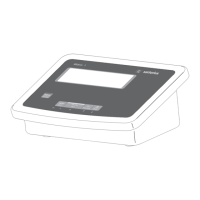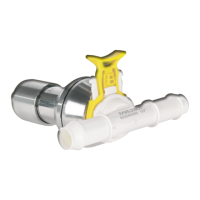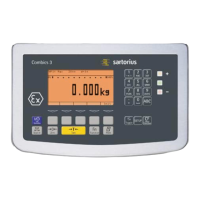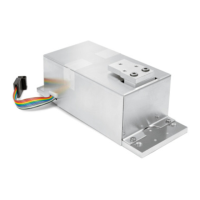Do you have a question about the Sartorius MIS1 and is the answer not in the manual?
Essential safety precautions for operation, handling, and environmental conditions.
Important considerations for electrical connections and safety during installation.
Specifies the IP protection rating and conditions required to maintain it.
Requirements for using the indicator in legal metrology applications, including verification.
Steps to follow to start the device, including connection and warm-up.
Instructions for connecting the device to the power supply, including safety measures.
Explains the purpose of ADC configuration for the connected load cell or weighing platform.
Detailed explanation of menu items for configuring ADC, including modes and classes.
Defines the scale interval (d) and its relation to verification scale interval (e).
Defines the verification scale interval (e) for legal metrology.
Explains the maximum load capacity and its relation to scale intervals.
Describes range selection modes: Single, Multi-interval, and Multiple-range.
Steps for testing and configuring the device for legal metrology use.
Details how to enter range limits and how accuracy changes with exceeding them.
Explains how the service menu provides access to additional setup items for calibration and adjustment.
Lists functions available when the service mode is active, such as service date and serial number entry.
Step-by-step guide on how to activate the service mode using specific key presses.
Refers to the procedure for activating the service mode.
Detailed example of entering values for standard configuration in single range mode.
Detailed example for standard configuration in a multi-interval scale mode.
Example for verifiable configuration in single range mode.
Example for verifiable configuration in multi-interval scale mode.
Explains the usual use of the key and additional functions allocatable in service mode.
Lists the menu structure for allocating functions to the key.
Explains why entering geographical data is necessary for external calibration.
Step-by-step guide for entering geographical data and performing external calibration.
Explains the purpose of entering calibration and linearization weights.
Outlines the menu structure for entering calibration and linearization weights.
Notes on conditions for external linearization in legal metrology and key allocation.
Step-by-step instructions for performing external linearization.
Explains calibration for accuracy checking and adjustment for error correction.
Steps to configure the Midrics for legal metrology use, including switch position.
Lists configurable parameters available for calibration/adjustment.
Example demonstrating external calibration with standard weights.
Procedures for setting or clearing the preload when the menu access switch is open.
Steps to prepare for calibration/adjustment, including switching on and selecting menus.
Notes on conditions for calibration without weights and legal metrology restrictions.
Steps for calibration without weights, including entering characteristic data.
Step-by-step guide to enter the weighing platform's serial number via the menu.
Details the main display in weighing mode, including application and battery symbols.
Example of assigning a password (AB2) to protect settings.
Provides an overview of the operating menu structure and available functions.
Parameters for the Counting application, covering minimum load, initialization, and resolution.
Parameters for Neutral Measurement, including minimum load, automatic taring, and resolution.
Parameters for Averaging application, including minimum load, automatic start, and animal activity settings.
Parameters for Checkweighing, including minimum load, taring, and activation of outputs.
Parameters for Classification, including minimum load, automatic taring, and number of classes.
Parameters for Weighing in Percent, including minimum load, taring, and display of calculated value.
Parameters for Net-total Formulation, including minimum load, taring, and printout settings.
Parameters for Totalizing, including minimum load, automatic saving, and data record/printout.
Settings related to calibration and adjustment procedures, including sequences and blocking functions.
How to enter the calibration weight value.
Steps to prepare for configuring printouts.
Explains the basic weighing function and its features, including zeroing and taring.
Describes how automatic taring works based on minimum load and stability.
Setting the minimum load for automatic taring and printing.
Example of entering ID code names like "Batch no." and "Cust.".
Example of entering ID code values, such as "123" for ID code 2.
Overview table comparing Midrics 1 and Midrics 2 capabilities for various applications and functions.
Describes features of the Counting application, including reference piece weight and sample quantity entry.
Methods for calculating the reference sample weight.
Method for entering reference sample weight directly via keypad.
Minimum load for initialization and autotaring in the Counting application.
Defines how resolution affects the calculation of reference values.
How weight values are saved based on platform stability.
Criteria for automatic updating of the average piece weight.
Describes features for measuring length, surface, and volume of parts.
Methods for calculating reference sample weight.
Method for entering reference weight via keypad.
Steps to prepare for the Neutral Measurement application.
Minimum load for initialization and autotaring in Neutral Measurement.
Options for displaying decimal places in results.
Describes features for calculating average weights, used for unstable samples like live animals.
Method for manual start with a preset number of measurements.
Method for manual start with a user-defined number of measurements.
Method for automatic start of averaging.
Minimum load for initialization and autotaring in Averaging application.
Conditions required for the averaging routine to begin.
Describes displaying weight relative to a defined reference weight as a percentage.
Methods for calculating reference weight.
Method for entering reference weight via keypad.
Minimum load for initialization and autotaring in Weighing in Percent.
How resolution affects reference value calculation.
How weight values are saved based on platform stability.
Options for displaying results as residue or loss.
Describes checking sample weight against target value or tolerance range.
Explains comparing current weight to target and defining tolerance limits.
Steps to prepare for the Checkweighing application.
Minimum load for automatic taring and printout in Checkweighing.
Describes classifying weights into defined classes based on limits.
Details entering upper class limits and percentage deviations.
Steps to prepare for the Classification application.
Minimum load for class definition and autotaring.
Describes adding weight values together in totalizing memory, including saving values and printouts.
Methods for saving weight values.
Explains the totalizing memory for adding values.
How to manually add a weight value.
How values are saved automatically based on stability and minimum load.
How to clear the totalizing memory.
Steps to prepare for the Totalizing application.
Minimum load for automatic taring and printing in Totalizing.
Minimum load for saving values in totalizing memory.
Configuration for data records and printouts in Totalizing.
Describes weighing in different components up to a defined total.
Minimum load for saving components in net-total memory.
Explains how error messages are shown in the main display.
Lists possible causes for various error codes and information messages.
Provides remedies for specific error codes and information messages.
Safety precautions for repairs, including power disconnection and use of original parts.
Conditions under which safe operation is no longer guaranteed.
Technical specifications of the weighing instrument, including readability, accuracy, and environmental conditions.
Regulates weighing instruments for legal metrology, including EC verification.
Declares conformity with relevant EC directives for electronic weighing instruments.
Declares type conformity for non-automatic weighing instruments.
Step-by-step guide for entering the password using the keypad.
Explains how to obtain and use documents for verifying weighing instruments.
Steps for filling out the Verification of Compatibility form.
Essential safety precautions for operation, handling, and environmental conditions.
Important considerations for electrical connections and safety during installation.
Specifies the IP protection rating and conditions required to maintain it.
Requirements for using the indicator in legal metrology applications, including verification.
Steps to follow to start the device, including connection and warm-up.
Instructions for connecting the device to the power supply, including safety measures.
Explains the purpose of ADC configuration for the connected load cell or weighing platform.
Detailed explanation of menu items for configuring ADC, including modes and classes.
Defines the scale interval (d) and its relation to verification scale interval (e).
Defines the verification scale interval (e) for legal metrology.
Explains the maximum load capacity and its relation to scale intervals.
Describes range selection modes: Single, Multi-interval, and Multiple-range.
Steps for testing and configuring the device for legal metrology use.
Details how to enter range limits and how accuracy changes with exceeding them.
Explains how the service menu provides access to additional setup items for calibration and adjustment.
Lists functions available when the service mode is active, such as service date and serial number entry.
Step-by-step guide on how to activate the service mode using specific key presses.
Refers to the procedure for activating the service mode.
Detailed example of entering values for standard configuration in single range mode.
Detailed example for standard configuration in a multi-interval scale mode.
Example for verifiable configuration in single range mode.
Example for verifiable configuration in multi-interval scale mode.
Explains the usual use of the key and additional functions allocatable in service mode.
Lists the menu structure for allocating functions to the key.
Explains why entering geographical data is necessary for external calibration.
Step-by-step guide for entering geographical data and performing external calibration.
Explains the purpose of entering calibration and linearization weights.
Outlines the menu structure for entering calibration and linearization weights.
Notes on conditions for external linearization in legal metrology and key allocation.
Step-by-step instructions for performing external linearization.
Explains calibration for accuracy checking and adjustment for error correction.
Steps to configure the Midrics for legal metrology use, including switch position.
Lists configurable parameters available for calibration/adjustment.
Example demonstrating external calibration with standard weights.
Procedures for setting or clearing the preload when the menu access switch is open.
Steps to prepare for calibration/adjustment, including switching on and selecting menus.
Notes on conditions for calibration without weights and legal metrology restrictions.
Steps for calibration without weights, including entering characteristic data.
Step-by-step guide to enter the weighing platform's serial number via the menu.
Details the main display in weighing mode, including application and battery symbols.
Example of assigning a password (AB2) to protect settings.
Provides an overview of the operating menu structure and available functions.
Parameters for the Counting application, covering minimum load, initialization, and resolution.
Parameters for Neutral Measurement, including minimum load, automatic taring, and resolution.
Parameters for Averaging application, including minimum load, automatic start, and animal activity settings.
Parameters for Checkweighing, including minimum load, taring, and activation of outputs.
Parameters for Classification, including minimum load, automatic taring, and number of classes.
Parameters for Weighing in Percent, including minimum load, taring, and display of calculated value.
Parameters for Net-total Formulation, including minimum load, taring, and printout settings.
Parameters for Totalizing, including minimum load, automatic saving, and data record/printout.
Settings related to calibration and adjustment procedures, including sequences and blocking functions.
How to enter the calibration weight value.
Steps to prepare for configuring printouts.
Explains the basic weighing function and its features, including zeroing and taring.
Describes how automatic taring works based on minimum load and stability.
Setting the minimum load for automatic taring and printing.
Example of entering ID code names like "Batch no." and "Cust.".
Example of entering ID code values, such as "123" for ID code 2.
Overview table comparing Midrics 1 and Midrics 2 capabilities for various applications and functions.
Describes features of the Counting application, including reference piece weight and sample quantity entry.
Methods for calculating the reference sample weight.
Method for entering reference sample weight directly via keypad.
Minimum load for initialization and autotaring in the Counting application.
Defines how resolution affects the calculation of reference values.
How weight values are saved based on platform stability.
Criteria for automatic updating of the average piece weight.
Describes features for measuring length, surface, and volume of parts.
Methods for calculating reference sample weight.
Method for entering reference weight via keypad.
Steps to prepare for the Neutral Measurement application.
Minimum load for initialization and autotaring in Neutral Measurement.
Options for displaying decimal places in results.
Describes features for calculating average weights, used for unstable samples like live animals.
Method for manual start with a preset number of measurements.
Method for manual start with a user-defined number of measurements.
Method for automatic start of averaging.
Minimum load for initialization and autotaring in Averaging application.
Conditions required for the averaging routine to begin.
Describes displaying weight relative to a defined reference weight as a percentage.
Methods for calculating reference weight.
Method for entering reference weight via keypad.
Minimum load for initialization and autotaring in Weighing in Percent.
How resolution affects reference value calculation.
How weight values are saved based on platform stability.
Options for displaying results as residue or loss.
Describes checking sample weight against target value or tolerance range.
Explains comparing current weight to target and defining tolerance limits.
Steps to prepare for the Checkweighing application.
Minimum load for automatic taring and printout in Checkweighing.
Describes classifying weights into defined classes based on limits.
Details entering upper class limits and percentage deviations.
Steps to prepare for the Classification application.
Minimum load for class definition and autotaring.
Describes adding weight values together in totalizing memory, including saving values and printouts.
Methods for saving weight values.
Explains the totalizing memory for adding values.
How to manually add a weight value.
How values are saved automatically based on stability and minimum load.
How to clear the totalizing memory.
Steps to prepare for the Totalizing application.
Minimum load for automatic taring and printing in Totalizing.
Minimum load for saving values in totalizing memory.
Configuration for data records and printouts in Totalizing.
Describes weighing in different components up to a defined total.
Minimum load for saving components in net-total memory.
Explains how error messages are shown in the main display.
Lists possible causes for various error codes and information messages.
Provides remedies for specific error codes and information messages.
Safety precautions for repairs, including power disconnection and use of original parts.
Conditions under which safe operation is no longer guaranteed.
Technical specifications of the weighing instrument, including readability, accuracy, and environmental conditions.
Regulates weighing instruments for legal metrology, including EC verification.
Declares conformity with relevant EC directives for electronic weighing instruments.
Declares type conformity for non-automatic weighing instruments.
Step-by-step guide for entering the password using the keypad.
Explains how to obtain and use documents for verifying weighing instruments.
Steps for filling out the Verification of Compatibility form.
| Brand | Sartorius |
|---|---|
| Model | MIS1 |
| Category | Accessories |
| Language | English |










